MGT303 Chapter 7 Readings AND Videos
1/59
There's no tags or description
Looks like no tags are added yet.
Name | Mastery | Learn | Test | Matching | Spaced |
|---|
No study sessions yet.
60 Terms
Selection:
The process of choosing individuals with the correct qualifications needed to fill jobs in an organization
Placement:
Fitting a person to the right job.
Person Environment Fit Chart:
See ss.

Person org fit:
The congruence between individuals and organizational factors
Person/group fit:
The congruence between individuals and group or work unit dynamics.
Person/job fit:
Matching the knowledge, skills, abilities, and motivations of individuals with the requirements of the job.
ASA Theory (Attraction, Selection, Attrition):
Job candidates are attracted to and selected by firms where similar types of individuals are employed, and individuals who are very different quit their jobs to work elsewhere.
Talent Acquisition Functions and Primary Responsibilities:
See ss.
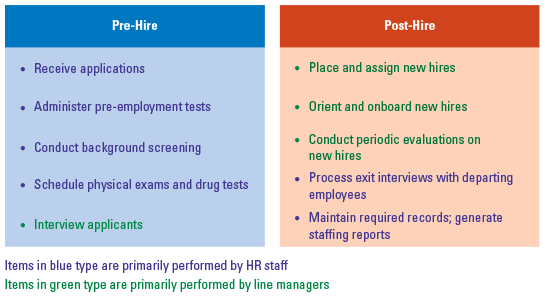
Logic prediction:
The best predictor of future behavior is often past behavior.
Job Performance, Selection Criteria, and Predictors:
See ss.
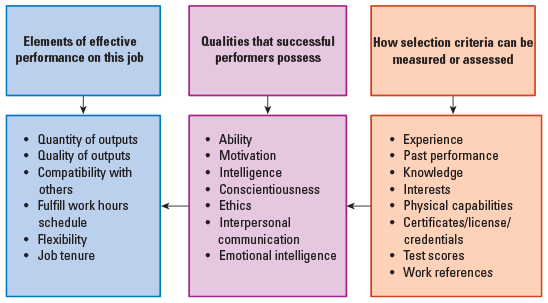
Selection criterion:
Characteristic that a person must possess to successfully perform job duties.
Predictors of selection criteria:
Measurable or visible indicators of selection criteria.
Reliability:
The extent to which a test or measure repeatedly produces the same results over time.
Validity:
The extent to which a test measures what it claims to measure.
Errors in decision making chart:
See ss. In quadrant A, the results of the selection test indicate that the applicant will not perform well on the job. However, if the person were hired anyway, he or she would turn out to be a high performer. That’s the false negative. In quadrant B, the results of the selection test indicate that the applicant will be a high performer. The person is hired and they are a high performer.
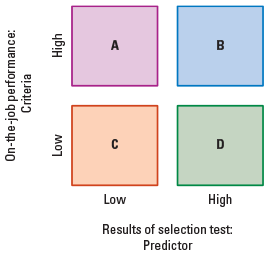
Concurrent validity:
Measured when an employer tests current employees and correlates the scores with their performance ratings.
Concurrent and predictive criterion validity study process:
See ss.
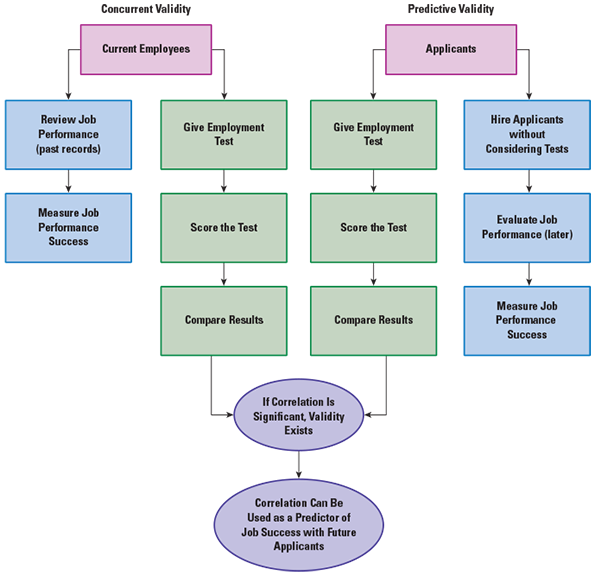
Predictive validity:
Measured when applicants’ test results are compared with subsequent job performance.
Two approaches for combining predictors:
Multiple hurdles: A minimum cutoff is set on each predictor, and each minimum level must be “passed.” For example, to be hired, a candidate for a sales representative job must achieve a minimum education level, a certain score on a sales aptitude test, and a minimum score on a structured interview.
Compensatory approach: Scores from individual predictors are added and combined into an overall score, thereby allowing a higher score on one predictor to offset, or compensate for, a lower score on another. The combined index takes into consideration performance on all predictors. For example, the NFL uses college athlete performance, the NFL combine assessment, and physical measures when making decisions about drafting players. A higher overall score on college performance might offset a lower score on the NFL combine performance test.
Typical selection process:
See ss.
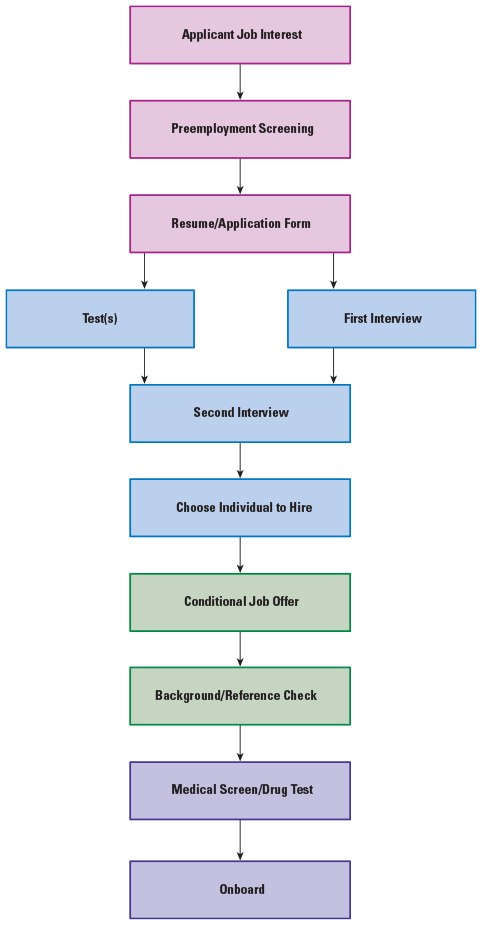
Job-relatedness:
A qualification or requirement in selection is significantly related to successful performance of job duties.
Realistic job previews:
Process through which a job applicant receives an accurate picture of a job.
5 purposes of application form for jobs:
It is a record of the applicant’s desire to obtain a position.
It provides the interviewer with an applicant profile that can be addressed during the interview.
It is a basic employee record for applicants who are hired.
It can be used for research on the effectiveness of the selection process.
It is a formal document on which the applicant attests to the truthfulness of all information provided.
Recommended Application Disclaimers aka Disclosures:
At-will employment: Indicates the right of the employer or the employee to terminate employment at any time with or without notice or cause (where applicable by state law)
Reference contacts: Requests permission to contact previous employers listed by the applicant on the application form or résumé
Employment testing: Notifies applicants of required drug tests, pencil-and-paper tests, physical exams, or electronic or other tests that will be used in the employment decision
Application time limit: Indicates how long application forms are active (typically six months) and that individuals must reapply or reactivate their applications after that period
Information falsification: Conveys to an applicant that falsification of application information can be grounds for serious reprimand or termination
Illegal things to ask on job applications:
Marital status
Height and weight
Number and ages of dependents
Information on spouse
Date of high school graduation
Emergency contact information
Social Security number
Ability, aptitude, aka achievement tests:
Tests that assess an individual’s ability to perform in a specific manner. Aptitude tests attempt to measure potential, while achievement tests attempt to measure demonstrated skill or competence.
Cognitive ability tests:
Tests that measure an individual’s thinking, memory, reasoning, verbal, and mathematical abilities.
Valid tests = Wonderlic Personnel Test and General Aptitude Test Battery (GATB).
Physical ability tests:
Tests that measure an individual’s physical abilities such as strength, endurance, and muscular movement.
Psychomotor Tests:
Tests that measure dexterity, hand–eye coordination, arm–hand steadiness, and other factors.
Work sample tests:
Tests that require an applicant to perform a simulated task that is a specified part of the target job.
Situational judgment tests:
Tests that measure a person’s judgment in work settings.
Big Five Personality Characteristics:
Extroversion, Agreeableness, Conscientiousness, neuroticism, and openness to experience.
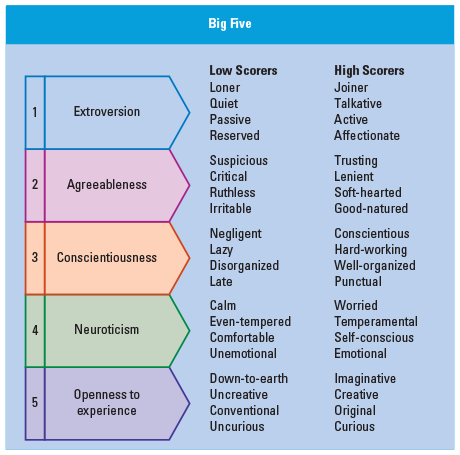
Emotional intelligence:
The ability to recognize and manage our own feelings and the feelings of others.
Dimensions of emotional intelligence:
Self-awareness, social awareness, self-management, and relationship management.
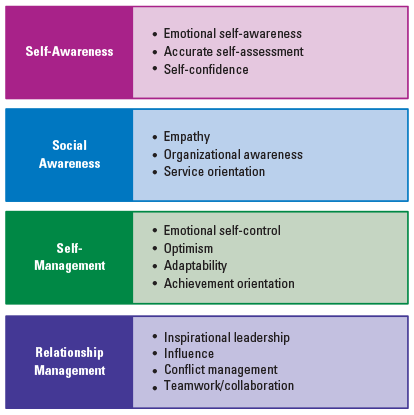
Employee Polygraph Protection Act:
Prohibits most private-sector employers from using polygraphs for pre-employment screening purposes. HOWEVER, federal, state, and local governments are exempt. Private sectors ex security and pharamaceutical companies are also exempt. Those employers can use polygraph tests for internal investigations of theft or loss.
Intra vs inter rater reliability:
Intra-rater reliability: Within the same interviewer.
Inter-rater reliability: Across different interviewers.
Structured vs unstructured selection interviews:
See ss.
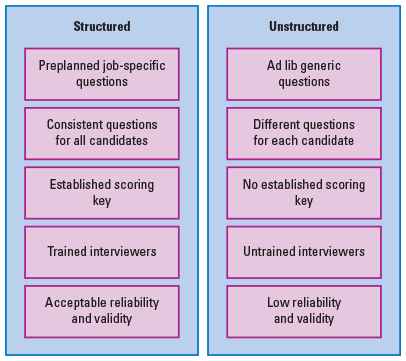
Structured interview:
Interview that uses a set of prepared job-related questions that are asked of all applicants.
Biographical interview:
Focuses on chronological assessment of candidate’s past experiences.
Behavioral interview:
Interview in which applicants give specific examples of how they have performed a certain task or handled a problem in the past.
Situational interview:
Structured interview that contains questions about how applicants might handle specific job situations.
Variation of situational interview:
Case study interview (requires a job candidate to diagnose and correct org challenges during the interview).
Unstructured interview:
Occurs when the interviewer improvises by asking questions that are not predetermined
Semistructured interview:
Guided conversation in which broad questions are asked and new questions arise as a result of the discussion.
STAR method for employment interviewers:
Helps separate great applicants from the rest. STAR = Situation, task, action, and result. Basically answer with CAR (cause action result) method in interviews and they’ll see that you’re competent.
Group interview:
Several job candidates are interviewed together by a hiring authority.
Nondirective interview:
Interview that uses questions developed from the answers to previous questions.
Panel interview:
Interview in which several interviewers meet with the candidate at the same time.
Team interview:
Interview in which applicants are interviewed by the team members with whom they will work.
FAQ Selection interviews:
See ss.
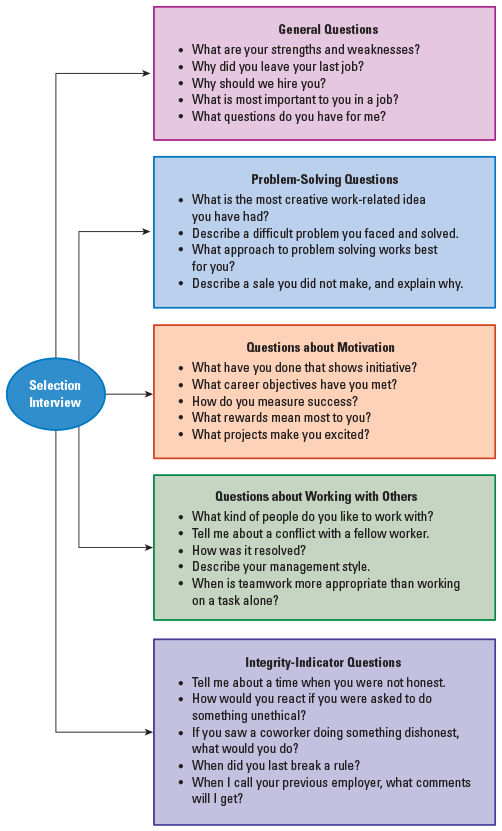
Problems in HR interviews:
Snap judgments: Some interviewers decide whether an applicant is suitable within the first two to four minutes of the interview and spend the rest of the time looking for evidence to support their judgment.
Negative emphasis: When evaluating suitability, unfavorable information about an applicant is often emphasized more than favorable information.
Halo effect: The halo effect occurs when an interviewer allows a positive characteristic, such as agreeableness, to overshadow other evidence. The phrase devil’s horns describes the reverse of the halo effect; this occurs when a negative characteristic, such as inappropriate dress, overshadows other traits.
Biases and stereotyping: “Similarity” bias occurs when interviewers favor or select people whom they believe to be like themselves on the basis of a variety of personal factors. Interviewers should also avoid any personal tendencies to stereotype individuals because of demographic characteristics and differences.
Cultural noise: Interviewers must learn to recognize and handle cultural noise, which results from social mores and cultural values and leads to responses that applicants believe are socially acceptable rather than factual.
Negligent hiring:
Occurs when an employer fails to check an employee’s background and the employee injures someone on the job.
Negligent retention:
Occurs when an employer becomes aware that an employee may be unfit for work but continues to employ the person, and the person injures someone.
Purpose of conducting previous employment checks:
See ss.
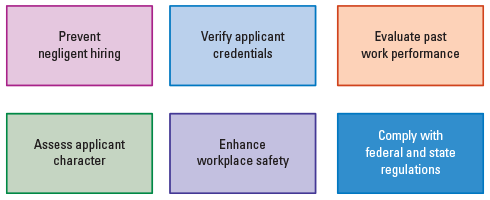
Previous job tenure:
A measure of how long the applicant has stayed on jobs held in the past.
Elements of employment offer letter:
See ss.

Onboarding:
The processes by which new hires are integrated into the organization.
Components of onboarding program:
See ss.

The Future of Hiring - No Resume Needed | Ben Rubenstein | TEDxYouth@Austin notes:
-Says personality + who you are will be more important than resume in hiring
-Says multiple professions throughout career
-3 traits necessary for success: Coachability (the ability to take and implement feedback quickly), work ethic (ramping up fast), and attitude.
-Call managers “trainers” at work because they’re meant to improve people and hold people accountable, like at the gym. Paid to make you better.
-People who are happy become successful. People who are successful are not always happy.
The Contradictions That Drive Toyota’s Success HBR article summary:
-TPS = Toyota Production system aka manufacturing and process innovations is important but so is Toyota culture of contradictions. Toyota culture of contradictions = Ability to embrace and balance opposing forces (such as being efficient but allowing downtime for learning). This leads to continuous improvement, innovation, and long-term growth.
Cultural mindset + managing paradoxes rather than solving them is how Toyota’s success is enduring.